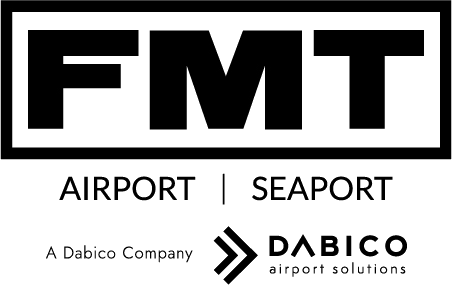Airport Passenger Service
Airport
Dabico FMT Passenger Boarding Bridges are developed in-house and tailor-made for each customer’s specific demands.
Dabico FMT has a unique range of Passenger Boarding Bridges including Mobile Telescopic Bridges (Apron Drive), Nose- Loader Bridges, T-Bridges, Commuter Bridges and Over-The-Wing Bridges.
The products are sold on the world market with the possibility for seamless integration with Docking Systems and Apron Management Systems for highly advanced airport gate systems. Dabico FMT is well-known for its high quality and modern design with the highest technical range of components.
Our Wide range of Airport Bridges
Can t find what you are looking for?, No Problem
Mobile Telescopic Bridge
A380 Upper Deck Service
Dual Boarding Bridge System
Nose-Loader Bridge
T-Bridge
Over-The-Wing Bridge
Commuter Bridge
Mobile Telescopic Bridge

The Dabico FMT Mobile Telescopic Bridge (MTB) was developed in 1992 to simplify operations and lower maintenance costs for the airport operator. Dabico FMT continually refines MTB to meet safety requirements, customer specifications, and driveability for the operator.
Dabico FMT MTB is able to serve all commercial aircraft, including ICAO Category C, D, E, and F, including the upper deck of the Airbus A380.
Noticeable technical features include the hydraulic lift system for maximum safety and availability in all environments, including hot and cold, wet and dry climates around the world.
Dabico FMT MTB can, as an option, be equipped with a Dabico FMT Safety Floor to further prevent damage to the fuselage. The Dabico FMT MTB stops at a safe distance from the fuselage, and the Dabico FMT Safety Floor is then extended to the fuselage. The Dabico FMT Safety Floor is spring-loaded to ensure that the pressure on the fuselage is kept to a minimal force.
A380 Upper Deck Bridge

The Dabico FMT Mobile Telescopic Bridges (MTB) are well suited for upper deck service by their rigid structural design and with the optional Dabico FMT Dual Drive Bogie System.
Safety and operator convenience is put on focus when designing a passenger bridge servicing aircraft doors more than seven meters above the apron.
In order to minimize sway, especially when driving sidewise, the Dabico FMT Dual Drive Bogie System is an option.
The Dabico FMT Upper Deck MTB is equipped with Dabico FMT Safety Floor, as standard, to prevent damage to the fuselage. The Dabico FMT Upper Deck MTB stops at a safe distance from the fuselage and the Safety Floor is then extended to the fuselage. The Dabico FMT Safety Floor is spring-loaded to ensure that the pressure on the fuselage is kept to a minimal force.
Dual Boarding Bridge System

The Dabico FMT Mobile Telescopic Bridges (MTBs) are very well suited for installation at airport stands with two or three Passenger Boarding Bridges of its advanced electronic anti-collision system.
Dabico FMT Mobile Passenger Boarding Bridges are very well suited for installation at MARS stands with an advanced electronic anti-collision system. The easy-to-understand system HMI is appreciated by operators.
Nose-Loader Bridge

The Dabico FMT Nose-Loader type of Passenger Boarding Bridge is continuously developed since its first installation in 1972. The Dabico FMT Nose-Loader Bridge consists of a telescopic tunnel which is extending to connect with the aircraft door. The Telescopic tunnel is elevated by a hydraulic cylinder.
The Nose-Loader type of bridge will take the slope from the terminal building in the fixed tunnel section from the terminal to the main bridge support and from there also in the telescopic tunnel which is elevating up and down.
The Nose-Loader type of bridge has advantages with regards to simple service and maintenance with low costs due to less movable parts compared to the Apron Drive type of Passenger Boarding Bridges.
The Nose-Loader type of bridge is a preferred type for airports with extreme environmental conditions like cool and snowy winters and/or hot and humid summers with hard winds.
T-Bridge

The Dabico FMT T-Bridge type of Passenger Boarding Bridge was developed in the mid-1970s for use at airport stands where the geometric conditions do not allow for Nose-Loader type of bridges.
The T-Bridge takes the slope in the long sloping tunnel from the terminal building. One large advantage of the T-Bridge is the always horizontal telescopic section which connects to the aircraft door. A very convenient passage for passengers, especially elderly and disabled persons.
The Telescopic tunnel section is elevated by a hydraulic cylinder.
The T-Bridge type of bridge has advantages with regards to simple service and maintenance with low costs due to less movable parts compared to the Apron Drive type of Passenger Boarding Bridges. The T-Bridge type of bridge is a preferred type for airports with extreme environmental conditions like cool and snowy winters and/or hot and humid summers with hard winds.
Over-The-Wing Bridge

The Dabico FMT Over-The-Wing (OTW) type of Passenger Boarding Bridge was originally developed at the end of the 1980s for use with DC-9 and MD-80 type of aircraft.
Already at that time, it was proven the OTW Bridge can reduce the turnaround time by about 50%.
The second generation of OTW Bridge was developed around the year 2000 and made mainly for the service of Boeing 737 aircraft.
The OTW connects to the aft door of an aircraft and is a complement to the front door bridge.
The OTW Bridge is operated from the front door bridge by a single push button, which starts the docking sequence where after the docking motion is entirely computer controlled. The time limitation for connection to the aft aircraft door is 1 minute! OTW Bridges for larger aircraft have been asked for by customers/airlines and Dabico FMT has an internal program for this work.
Commuter Bridge

The Commuter type of Passenger Boarding Bridge has been developed to provide passengers with a weather-protected walkway from the terminal building to the stair of a commuter type of aircraft.
The Commuter Bridge rotates around a fixed point at the terminal building and is able to telescope a tunnel section to approach the aircraft stair as close as possible. This type of movability allows the commuter aircraft to park power-in-power-out.
The Commuter Bridges are currently working in Denmark, Germany and in the United Kingdom.
The Connect Commuter is a more advanced version and protects the passengers completely from all rain- and snowfall. From the end of the walkway tunnel, a large bellow section will cover the aircraft stairs and thereby protect the passengers while entering the aircraft. Commuter Bridges are suitable for smaller airports with a ground floor terminal arrangement.
Key Benefits that comes with FMT Products
High Stability even in severe wind conditions
Stable
Anti collision system between two or three PBB.
Anti collision
Always horizontal floor at boarding area, for maximal passenger safety.
Safety
Saves turn-around time in both boarding and deboarding.
Save time
Previous
Next
Literature (Coming Soon)
Lorem Ipsum
Download
Lorem Ipsum
Download
Lorem Ipsum
Download
Lorem Ipsum
Download
- © 2023 FMT. All rights reserved.
Developed by Omnia Digital LLP.


